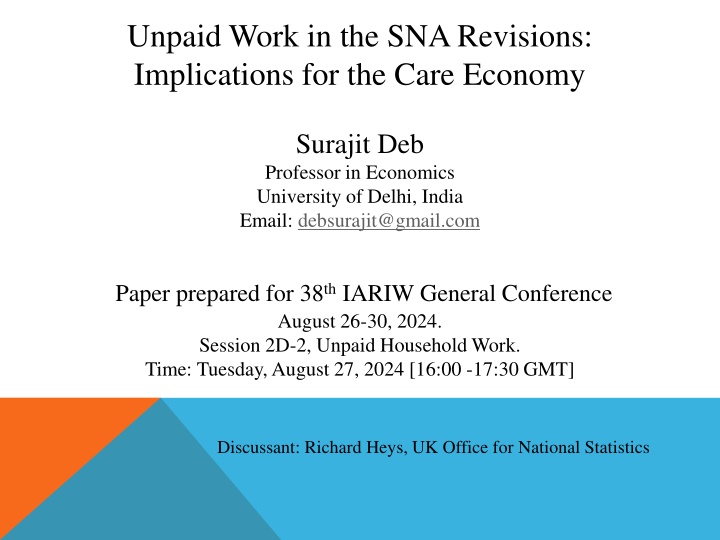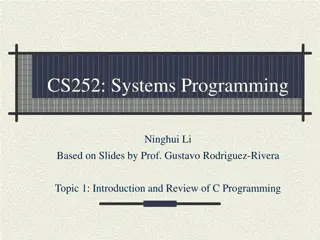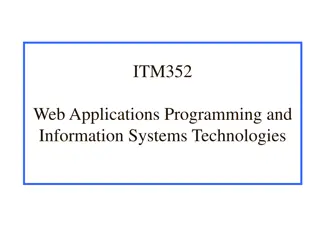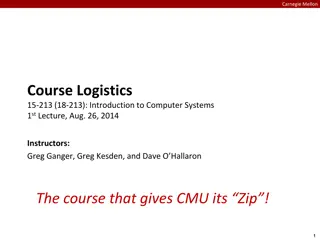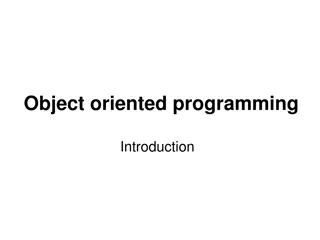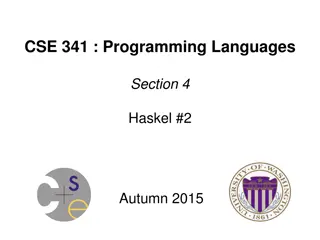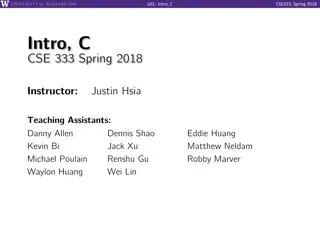Introduction to OO Programming in C++ Course
An introductory course in C++ programming covering syntax, rules, coding, compiling, and executing programs. The course includes program design, structured modular programming, arrays, report generation, and file processing. Basic testing concepts and techniques are also covered, such as defining testing, introducing terminology, test case classifications, and formalizing testing techniques.
Download Presentation

Please find below an Image/Link to download the presentation.
The content on the website is provided AS IS for your information and personal use only. It may not be sold, licensed, or shared on other websites without obtaining consent from the author.If you encounter any issues during the download, it is possible that the publisher has removed the file from their server.
You are allowed to download the files provided on this website for personal or commercial use, subject to the condition that they are used lawfully. All files are the property of their respective owners.
The content on the website is provided AS IS for your information and personal use only. It may not be sold, licensed, or shared on other websites without obtaining consent from the author.
E N D
Presentation Transcript
Unpaid Work in the SNA Revisions: Implications for the Care Economy Surajit Deb Professor in Economics University of Delhi, India Email: debsurajit@gmail.com Paper prepared for 38th IARIW General Conference August 26-30, 2024. Session 2D-2, Unpaid Household Work. Time: Tuesday, August 27, 2024 [16:00 -17:30 GMT] Discussant: Richard Heys, UK Office for National Statistics
Bottom Line Up Front Four key contributions: Strategic Unpaid work and the SNA Principles Methods for delivering Unpaid Work calculations Empirical Results from India Policy Implications - the problem of women shouldering a disproportionate share of unpaid work remains particularly acute in developing countries. Current research indicates that investing in the labor-intensive care economy could generate high levels of return through growth in women s employment and an increased level of social wellbeing Central point is the importance of valuation of unpaid work to measure economic output: with which I have absolute agreement.
Questions the paper sets itself i) what are the SNA review s proposals and whether they are adequate to capture the unpaid work within the SNA s output framework, ii) as to what extent different countries have undertaken the time use or labor surveys so that adequate data and information are ready to evaluate the values of unpaid work, iii) what are the evidences on unpaid work, particularly the women s contribution, iv) what are the implications for the care economy development from available research in world regions, and finally, v) what are the broad implications of women s unpaid caregiving work for the labor force participation from the TUS information on an emerging economy?
1. The SNA Revision The challenges involved in the measurement of unpaid household service work have been longstanding. For many years now, it has been debated whether its value should be included within estimates of output and economic growth. The production boundary of national accounts is a conceptual line drawn between economic and non-economic activity, and unpaid labor on housework, childcare, cleaning, meal preparation, and care for the children, elderly and sick are not valued in GDP data. UN (2020) [sets out] i). whether the production boundary should be extended for unpaid services and if so, should leisure time also be valued to better reflect the complete economic experience of households? ii). should additional value be added to GDP to capture an extended GDP including unpaid household service work and should this be recorded as part of the existing supply use tables within the core system of national accounts? iii) should supplementary tables be used for recording unpaid household activities in physical and monetary terms? iv) should a full set of time accounts be produced to measure how paid work time, unpaid work time and leisure time are proportioned across the population? v). how should unpaid work be valued for and can productivity levels be measured within the valuation process? vi). is it possible to create monetary valuations of unpaid work in volume terms?
2. Recommendations (1) 1. Unpaid Household Service Work definition: unpaid household services should include any activity which meets the third-party criterion i.e. contracted out to a market service provider (UN 2020). 2. The categories for use: unpaid childcare, adult care, nutrition, transport, household management services, laundry and clothing services, informal volunteering, shopping, information services, and other unpaid household production not elsewhere classified. 3. Two alternative approaches to measure and value households unpaid service work: the input approach and output approach. The input approach tries to monetize unpaid household service work by estimating the sum of costs of the various inputs needed to produce the relevant services: labor, capital services, and intermediate consumption. The output approach multiplies quantities for each household services with prices of similar services exchanged on the market. The output approach should be used as an alternative where TUS data is not available and the input approach cannot be applied
2. Recommendations (2) 4. Time Use data should be collected on a regular basis, at least once every five years to produce valuations of the unpaid labor. The TUS should be consistent and designed to collect as much activity meeting the third-party criterion as possible. 5. to derive estimates of extended GDP factoring in unpaid household service production to accompany the traditional GDP measures. It is therefore agreed upon that the exclusion of unpaid household service work may directly impact welfare if economic policy biases intervention to favor the paid economy over unpaid household production.
3. Time Use Surveys The estimates based on time-use survey data in 64 countries (representing 66.9 per cent of the world s working-age population) indicates that 16.4 billion hours are spent in unpaid care work every day. This is equivalent to 2 billion people working eight hours per day or a full-time shift for no remuneration (ILO, 2018). ILO (2019) provided a compilation of 133 time-use surveys carried out in 76 countries through diaries and national surveys. According to ILO (2019), the time spent in unpaid care work ranges from the maximum of 345 minutes (5 hours and 45 minutes or 24 per cent of a 24-hour day) for Iraq (2007) to the minimum of 11.7 per cent in Taiwan, China. The average time devoted to unpaid care work for women at the global level (including 75 countries) is 277 minutes (4 hours and 37 minutes or 19.7 per cent of a 24-hour day), whereas the men s average of unpaid is 111 minutes (1 hour and 51 minutes or 7.7 per cent of a 24-hour day). The average time spent by women and men in paid, unpaid and total work in 75 countries indicates that women devote 2.51 times more time in unpaid care work than men. The men spend a little bit more than half (0.57) times more time than women in paid work, but women spend 1.13 times
4. Time Use In India The National Statistical Office in India conducted the latest TUS during January- December 2019, and provided for the first time consistent data on all the major states of India (GoI 2020). The female participation rate in unpaid caregiving services remained twice the level of male participation at the all-India level. The extent of female participation remained about three times of the male participation in some of the states like Rajasthan, Madhya Pradesh and Odisha.
Section 1: Background & Objectives Section 2: SNA Proposals on Unpaid Work Section 3: Time Use Survey Information and Women s Work Section 4: Evidence on Gender Division of Unpaid Work Section 5: Care Economy Implications Section 6: Indications from Indian Time Use Survey Data: Section 7: Summary & Implications
Conclusions Massive topic which is often under-estimated by economic statisticians and policy- makers Measurement of unpaid work is also under-estimated growing international density of Time Use Surveys quality and range and consistency of data Clear macro-policy implications, not just on extended metrics, but also classic economic metrics. Quality paper showing diversity within Indian states as key as the diversity between countries. Key Questions Inputs method undoubtedly biased downwards simply makes under-estimation problems worse. How to grapple with output approaches? Five Yearly Time Use Surveys just simply not enough how to encourage greater political support? thank you
